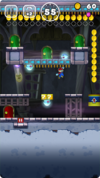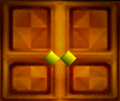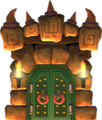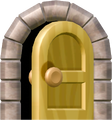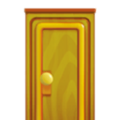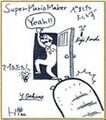Warp Door
- This article is about the doors appearing in many games of the Super Mario series. For the warp door from Wario: Master of Disguise, see Warp door (Wario: Master of Disguise).
- "Door" redirects here. For the door at the end of a level in the Mario vs. Donkey Kong series, see Goal Door (Mario vs. Donkey Kong series). For the doors in the Wrecking Crew series, see Door (Wrecking Crew series). For other kinds of doors in the Mario franchise, see Category:Doors.
| Warp Door | |||
|---|---|---|---|
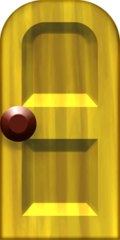 Artwork of a Warp Door from Super Mario Maker for Nintendo 3DS (New Super Mario Bros. U style) | |||
| First appearance | Super Mario Bros.: The Lost Levels (1986) | ||
| Latest appearance | Nintendo World Championships: NES Edition (2024) | ||
| |||
Warp Doors (or simply doors)[1] are objects appearing in several installments of the Super Mario series that take Mario, Luigi, or another character to another part of the level. Most of them are unlocked, while some, known as Key Doors, require a key to be opened. Some games feature P Warp Doors, which are blue doors that only appear while a P Switch is active.
History[edit]
Super Mario Bros.: The Lost Levels[edit]
In Super Mario Bros.: The Lost Levels (and to a much lesser extent, All Night Nippon: Super Mario Bros.), Warp Doors only appear in World 8-4 and World D-4, after Bowser (fake Bowser in the Family Computer Disk System version of World D-4) is defeated. Both lead to Princess Peach. Despite VS. Super Mario Bros. having the same ending as The Lost Levels and All Night Nippon, there is no door leading to Peach after Bowser is defeated, much like in the first game. The door does not appear in any of the SNES remakes, instead being replaced with Peach locked inside a cage suspended over a pit of lava.
Super Mario Bros. 2[edit]
In Super Mario Bros. 2, Warp Doors are the main means of transporting between areas. The game consists of three different types of Warp Doors: red swing-open ones, doorless entryways, and special doors with keyholes that require the player to search for the Key in Phantos' lairs to open those doors. They also serve as checkpoints as, on dying, the player would resume from the last door they passed through. In both the Super Mario All-Stars and Super Mario Advance versions, a pair of dark yellow double doors (similar to Super Mario World's) replaced doorless entryways while in the overworld areas, and a giant iron bar door with a Bob-omb emblem appears as the cave entrance in World 6-3.
Super Mario Bros. 3 / Super Mario Advance 4: Super Mario Bros. 3[edit]
Doorless entryways are also used in the Nintendo Entertainment System version of Super Mario Bros. 3. In both the Super Mario All-Stars and Super Mario Advance 4: Super Mario Bros. 3 versions, they are replaced with wooden doors. Big Warp Doors also appear in both of Bowser's boss arenas, which open after he is defeated, and both lead to Princess Toadstool. Another variant known as Magic Doors appear in World 4-6; when entered, Mario can transition between giant and normal-sized versions of the stage.
Super Mario World / Super Mario World: Super Mario Advance 2[edit]
Wooden Warp Doors, named Yellow Doors[2] or Yellow Exit Doors,[3] are used mainly in Ghost Houses, fortresses, and castles in Super Mario World and its reissue to transport Mario or Luigi to another room. Big red ones debut in this game, serving as boss rooms' entry points.
New Super Mario Bros. series[edit]
In the New Super Mario Bros. series, Warp Doors have appeared in many Ghost Houses, Castles and Towers, as well as at the end of each Castle and Tower throughout the series leading to the boss. The regular Warp Doors now has the control pad and an up arrow on them. Starting with New Super Mario Bros. Wii, tower boss doors are red, and castle boss doors are blue. Some doors in Ghost Houses are fake; if the player tries to open one, it disappears and four Boos run away, leaving a coin behind.
Super Mario 3D series[edit]
Warp Doors also appear in Super Mario 3D Land, Super Mario 3D World and Super Mario 3D World + Bowser's Fury, in Toad Houses and in some stages.
Super Mario Maker subseries[edit]
In Super Mario Maker and Super Mario Maker for Nintendo 3DS, Warp Doors can be used as course elements. They transport the player to a different part of the area. Up to 8 pairs of doors (4 pairs per area) can be placed in the level. As of the 1.20 update, players can knock multiple times on doors in the Course Maker to reveal Weird Mario. The 1.30 update introduces a variation: The P Warp Door, which cannot be activated until pressing a P Switch. Another variation introduced on the 1.40 update is the Key Door; they can only be opened with a key, another feature introduced in this update.
Warp Doors reappear as course elements in Super Mario Maker 2 under the Gizmos section and can be used in all game styles, including the Super Mario 3D World style. Like the previous game, players can knock multiple times on doors in the Course Maker to reveal Weird Mario.
Super Mario Run[edit]
Warp Doors appear in some courses in Super Mario Run, using their Ghost House appearance from New Super Mario Bros. U. They mainly appear in Ghost House courses, where they help the player advance from one room to another. A Warp Door also appears in Cutting Edge Spire where it takes the player outside the Tower and to the end of the course. The player enters Warp Doors by being on the ground while within their space, rather than through any separate input. The player cannot enter any Warp Door that they exited from. In interior areas of a Ghost House, such doors are red instead of green.
In the courses Ghost Door Deception, there are multiple fake doors and a real door in each room. The player can tell which door is fake by the fact that it shakes periodically. In Boohind Lock and Key, there is one Key Door in every room. Since the courses Fishing Boo Taunts You and Dark and Stormy take place entirely in the exterior of a Ghost House, they start at a cosmetic Warp Door.
In Remix 10, Warp Doors serve as the goal of courses in Ghost House interiors as well as in Cutting Edge Spire. This also means the Warp Door takes on some of the properties of the Goal Pole, in that entering one collects all gravity affected coins and converts Super Mushrooms and Super Stars that are not inside bubbles into five coins.
Super Mario Odyssey[edit]
Warp Doors appear again in Super Mario Odyssey. One type of Warp Door is colored red with a golden top hat in the middle of it that can only be opened by throwing Cappy at it. Another type is one that is colored blue that can only be opened by throwing Cappy onto a Scarecrow, thereby forcing Mario to traverse whatever is behind the Warp Door without the aid of Cappy. The third type of Warp Doors are pink-colored ones with locks on them that can only be opened by wearing a specific outfit and talking to the nearby NPC, who will allow Mario access to whatever is inside. The final type of Warp Doors are pink doors without locks, and they can lead Mario to different areas, such as a shop, the Slots minigame, or another area in the same kingdom.
Super Mario Bros. Wonder[edit]
Warp Doors appear once again in Super Mario Bros. Wonder, acting how they did in previous games. Additionally, an enemy called a Noknok is introduced in this game. This enemy disguises as a normal Warp Door, but when the player comes near, it opens up, revealing large teeth and legs. It then chases the player until they jump on it, stunning it and allowing the player to go in the door, either gaining a coin or warping.
Gallery[edit]
Front of a Warp Door from New Super Mario Bros.
New Super Mario Bros. 2 (Toad House)
New Super Mario Bros. U (Ghost House)
New Super Mario Bros. U (Peach's Castle)
Super Mario Maker 2 (Super Mario 3D World style icon)
2016 nengajō for Nintendo DREAM by developers of Super Mario Maker
Names in other languages[edit]
| Language | Name | Meaning | Notes |
|---|---|---|---|
| Japanese | ドア[?] Doa |
Door | |
| Chinese (simplified) | 门[?] Mén |
Door | |
| Chinese (traditional) | 門[?] Mén |
Door | |
| Dutch | Warpdeur[4] | Warp Door | |
| French | Télé-porte[5] | Pun on téléporter ("to teleport") and porte ("door") | |
| Porte[6] | Door | Yoshi's Story | |
| German | Warp-Tür[?] | Warp Door | |
| Italian | Porta teletrasporto[?] | Warp Door | |
| Portuguese (NOA) | Porta[?] | Door | |
| Portuguese (NOE) | Porta de Teletransporte[7] | Teleport Door | |
| Russian | Дверь-телепорт[?] Dver'-teleport |
Teleport Door | |
| Spanish | Puerta[?] | Door | |
| Spanish (NOA) | Puerta de teletransporte[?] | Teleporting door |
References[edit]
- ^ 2006. New Super Mario Bros. manual. Nintendo of America (American English). Page 20.
- ^ 1992. Nintendo Super NES Player's Guide. Nintendo of America (American English). Page 12.
- ^ 1992. Nintendo Super NES Player's Guide. Nintendo of America (American English). Page 13.
- ^ Nintendo Nederland (March 9, 2016). Super Mario Maker - Gesloten deuren! Spijkerzuilen! Roze munten! (Wii U). YouTube (Dutch). Retrieved May 19, 2019.
- ^ Nintendo France (December 17, 2015). Super Mario Maker - Nouvelles fonctionnalités ! (Wii U) (00:38). YouTube (French). Retrieved January 4, 2017.
- ^ Yoshi Story instruction booklet, French segment (PDF). Nintendo of Europe (French). Page 60.
- ^ Nintendo Portugal (December 17, 2015). Super Mario Maker - Novas funcionalidades! (Wii U). YouTube (European Portuguese). Retrieved January 11, 2021.
- Checkpoints
- Doors
- New Super Mario Bros. objects
- New Super Mario Bros. 2 objects
- New Super Mario Bros. U objects
- New Super Mario Bros. Wii objects
- Super Mario 3D Land objects
- Super Mario 3D World objects
- Super Mario Advance objects
- Super Mario Advance 4: Super Mario Bros. 3 objects
- Super Mario Bros. 2 objects
- Super Mario Bros. 3 objects
- Super Mario Bros. Wonder objects
- Super Mario Maker objects
- Super Mario Maker 2 objects
- Super Mario Odyssey objects
- Super Mario Run objects
- Super Mario World objects
